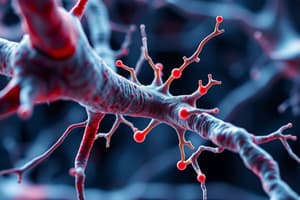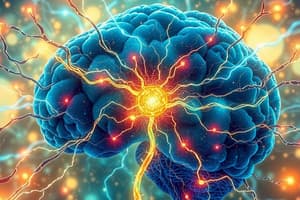Podcast
Questions and Answers
What triggers the movement of ions across the post-synaptic membrane?
What triggers the movement of ions across the post-synaptic membrane?
- Electrical impulses from the axon
- Neurotransmitter binding to receptors (correct)
- Action potentials reaching the terminal axon
- Inhibition from other neurons
What is the term for the potential created after the binding of neurotransmitters in the post-synaptic neuron?
What is the term for the potential created after the binding of neurotransmitters in the post-synaptic neuron?
- Post-synaptic potential (PSP) (correct)
- Resting potential
- Action potential
- Graded potential
Where does the post-synaptic potential (PSP) flow to in the neuron?
Where does the post-synaptic potential (PSP) flow to in the neuron?
- Axon hillock (correct)
- Soma only
- Dendrites only
- Synaptic cleft
What happens at the axon hillock in relation to the post-synaptic potential?
What happens at the axon hillock in relation to the post-synaptic potential?
What role do dendrites play in the post-synaptic electrophysiology?
What role do dendrites play in the post-synaptic electrophysiology?
What is a significant characteristic of sponges in relation to their nervous system?
What is a significant characteristic of sponges in relation to their nervous system?
What does cephalization refer to in the evolution of the nervous system?
What does cephalization refer to in the evolution of the nervous system?
Which animals possess a nerve net system without axons or dendrites?
Which animals possess a nerve net system without axons or dendrites?
What characteristic of the nervous system do planarians exhibit?
What characteristic of the nervous system do planarians exhibit?
Which group of animals has a complex lobed brain and a highly cephalized nervous system?
Which group of animals has a complex lobed brain and a highly cephalized nervous system?
What is a defining feature of the nervous systems in echinoderms?
What is a defining feature of the nervous systems in echinoderms?
What distinguishes the nervous system of arthropods from that of molluscs?
What distinguishes the nervous system of arthropods from that of molluscs?
Which statement accurately describes the processing capabilities in the nervous systems of different animal groups?
Which statement accurately describes the processing capabilities in the nervous systems of different animal groups?
What effect does the opening of Na+ channels in a dendrite have on the postsynaptic membrane?
What effect does the opening of Na+ channels in a dendrite have on the postsynaptic membrane?
What is the primary characteristic of EPSPs and IPSPs compared to action potentials?
What is the primary characteristic of EPSPs and IPSPs compared to action potentials?
Which of the following channels would cause a hyperpolarizing or inhibitory PSP?
Which of the following channels would cause a hyperpolarizing or inhibitory PSP?
How does the size of a postsynaptic potential (PSP) vary?
How does the size of a postsynaptic potential (PSP) vary?
What is the role of summation in postsynaptic neurons?
What is the role of summation in postsynaptic neurons?
All neurons exhibit the same basic electrophysiology, but how is diversity achieved in postsynaptic regulation?
All neurons exhibit the same basic electrophysiology, but how is diversity achieved in postsynaptic regulation?
Which of the following best describes the influence of multiple synaptic inputs on a postsynaptic neuron?
Which of the following best describes the influence of multiple synaptic inputs on a postsynaptic neuron?
What ion flow is primarily responsible for generating an inhibitory postsynaptic potential (IPSP)?
What ion flow is primarily responsible for generating an inhibitory postsynaptic potential (IPSP)?
What is bioelectricity primarily a result of?
What is bioelectricity primarily a result of?
Which division of the Autonomic Nervous System is responsible for 'rest and digest' functions?
Which division of the Autonomic Nervous System is responsible for 'rest and digest' functions?
Which neurotransmitter is primarily associated with the sympathetic division's postganglionic fibers?
Which neurotransmitter is primarily associated with the sympathetic division's postganglionic fibers?
What type of receptor do acetylcholine act on in the postganglionic fibers of the parasympathetic division?
What type of receptor do acetylcholine act on in the postganglionic fibers of the parasympathetic division?
What is the overall effect of the sympathetic division during stress?
What is the overall effect of the sympathetic division during stress?
What best describes the nature of the Autonomic Nervous System's divisions?
What best describes the nature of the Autonomic Nervous System's divisions?
Which part of the Autonomic Nervous System is more organ-specific?
Which part of the Autonomic Nervous System is more organ-specific?
What happens to airway resistance during sympathetic activation?
What happens to airway resistance during sympathetic activation?
How does the ANS contribute to homeostasis?
How does the ANS contribute to homeostasis?
What characterizes the structure of the ANS?
What characterizes the structure of the ANS?
Which system is characterized as the 'flight or fight' response?
Which system is characterized as the 'flight or fight' response?
What occurs when the parasympathetic division is more active?
What occurs when the parasympathetic division is more active?
What is the role of feedback loops in the ANS?
What is the role of feedback loops in the ANS?
In what way do nervous systems in different animal groups reflect their environments?
In what way do nervous systems in different animal groups reflect their environments?
Flashcards
Post-synaptic Electrophysiology
Post-synaptic Electrophysiology
The process involving ion movement across the post-synaptic membrane triggered by neurotransmitter binding.
Electrotonic Potential (EP)
Electrotonic Potential (EP)
A local change in membrane potential in dendrites due to post-synaptic neurotransmitter activity.
Post-synaptic Potential (PSP)
Post-synaptic Potential (PSP)
The potential generated from the electrotonic potential at the dendrites flowing to the axon hillock.
Dendrites
Dendrites
Signup and view all the flashcards
Axon Hillock
Axon Hillock
Signup and view all the flashcards
EPSP
EPSP
Signup and view all the flashcards
IPSP
IPSP
Signup and view all the flashcards
Graded Potentials
Graded Potentials
Signup and view all the flashcards
Summation of PSPs
Summation of PSPs
Signup and view all the flashcards
Neurotransmitter Influence
Neurotransmitter Influence
Signup and view all the flashcards
Postsynaptic Neuron Inputs
Postsynaptic Neuron Inputs
Signup and view all the flashcards
Diversity of Synaptic Regulation
Diversity of Synaptic Regulation
Signup and view all the flashcards
Sponges
Sponges
Signup and view all the flashcards
Ganglia
Ganglia
Signup and view all the flashcards
Cephalization
Cephalization
Signup and view all the flashcards
Nerve Net
Nerve Net
Signup and view all the flashcards
Planarians
Planarians
Signup and view all the flashcards
Arthropods
Arthropods
Signup and view all the flashcards
Molluscs
Molluscs
Signup and view all the flashcards
Vertebrates
Vertebrates
Signup and view all the flashcards
Bioelectricity
Bioelectricity
Signup and view all the flashcards
Somatic Division
Somatic Division
Signup and view all the flashcards
Autonomic Division
Autonomic Division
Signup and view all the flashcards
Sympathetic Division
Sympathetic Division
Signup and view all the flashcards
Parasympathetic Division
Parasympathetic Division
Signup and view all the flashcards
Efferent Neurons
Efferent Neurons
Signup and view all the flashcards
Afferent Neurons
Afferent Neurons
Signup and view all the flashcards
Neurotransmitters
Neurotransmitters
Signup and view all the flashcards
Acetylcholine
Acetylcholine
Signup and view all the flashcards
Norepinephrine
Norepinephrine
Signup and view all the flashcards
Receptor Types
Receptor Types
Signup and view all the flashcards
Antagonistic Effects
Antagonistic Effects
Signup and view all the flashcards
Feedback Loops
Feedback Loops
Signup and view all the flashcards
Homeostasis
Homeostasis
Signup and view all the flashcards
Integration in ANS
Integration in ANS
Signup and view all the flashcards
Study Notes
Animal Body Systems - Nervous Systems
- Lecture 9 covers post-synaptic electrophysiology, the autonomic nervous system (ANS), and nervous system evolution.
- The supplementary reading material is found in textbook chapter 42, pages 1159-1164, and 1171-1175 (5th edition).
Post-Synaptic Electrophysiology
- Ions move across the post-synaptic membrane due to neurotransmitter binding to receptors.
- This creates an electrotonic potential (EP) in the postsynaptic neuron's dendrites.
- The EP flows along the membrane surface to the axon hillock.
- A postsynaptic potential (PSP) results from the EP from the dendrites.
Post Synaptic Potentials
- Postsynaptic potentials (PSPs) can depolarize or hyperpolarize the membrane.
- The type of receptor/ion channel determines whether the PSP is excitatory (EPSP) or inhibitory (IPSP).
- Na+ channels cause depolarizing/excitatory PSPs when Na+ flows inward.
- K+ channels cause hyperpolarizing/inhibitory PSPs when K+ flows outward.
- Cl- channels cause hyperpolarizing/inhibitory PSPs when Cl- flows inward
PSP's are Graded Potentials
- EPSPs and IPSPs are graded potentials, not all-or-none like action potentials (APs).
- The size of the PSP at each receptor depends on the amount of neurotransmitter released.
Postsynaptic Neurons Receive Many Inputs
- A postsynaptic neuron can receive up to 1,000 inputs.
Summation of PSPs
- Summation can occur in time and space involving EPSPs and IPSPs.
- This is essential for processing inputs, learning, and memory.
- The summation of subthreshold PSPs happens at the axon hillock.
Overview of Neuronal Signaling Physiology
- This overview details the steps in neuronal signaling.
Post Synaptic Regulation
- All neurons share the same basic electrophysiology.
- Variations in postsynaptic regulation occur via differing neurotransmitters, receptors, and intracellular signaling pathways.
- This allows the nervous system to regulate virtually all cellular physiology.
Summary
- Integration is the synthesis of an output based on the sum of inputs.
Functional Divisions
- Somatic Nervous System: voluntary control.
- Autonomic Nervous System: involuntary control, encompassing:
- Sympathetic division: "fight or flight", whole-body responses.
- Parasympathetic division: "rest and digest", organ-specific responses.
The Autonomic Nervous System (ANS)
- Most tissues are innervated by both sympathetic and parasympathetic divisions.
- Integration also occurs in ganglia with two efferent neurons & peripheral ganglia.
The ANS Divisions
- Sympathetic Division: more widespread effects (whole body).
- Parasympathetic Division: effects are more organ-specific.
Functions of the ANS
- Sympathetic Division: Relaxes airways, increases heartbeat, inhibits digestion/stomach activity.
- Parasympathetic Division: Constricta airways, slows heartbeat, stimulates digestion/stomach activity.
Neurotransmitters & Receptors of the ANS
- Sympathetic: Preganglionic fibers release acetylcholine (ACh) and nicotinic receptors, Postganglionic fibers release norepinephrine (NE)/and renorphin/adrenoceptors.
- Parasympathetic: Preganglionic fibers release ACh/nicotinic receptors, Postganglionic fibers release ACh/muscarinic receptors.
ANS Divisions have Antagonistic (Opposing) Effects.
- Sympathetic is more active when the body's energy stores need to be used ("fight or flight".)
- Parasympathetic is more active when body energy stores are being conserved ("rest and digest").
- Example: Sympathetic inhibits digestive tract but the parasympathetic system stimulates it.
The ANS Activity
- Both divisions (sympathetic and parasympathetic) are always active.
- The overall effect depends on which division is more active at any given moment.
ANS Summary
- A major source of integration in the body.
- Used to regulate and coordinate the majority of organ systems.
- Extensive feedback loops maintain homeostasis.
Pressures on Nervous System Development
- Nervous systems of all animals are designed for optimal functioning.
- Invertebrates and vertebrates have different nervous system organization reflecting differences in lifestyle and habitat.
Nervous System Evolution in Animals
- Sponges lack neurons but have basic cell physiology.
- Ganglia are collections of neuron cell bodies that are sites of integration.
- Cephalization is the concentration of neurons/ganglia in a head region.
Nervous System Evolution in Chordates
- Brain regions are conserved and modified in different chordate lineages.
The Mammalian Nervous System - An Example of Complexity
- Folding increases the surface area of the brain (# of neurons/synapses).
Development of the Human Brain
- Different regions of the brain develop and have specific functions.
An Example of Complexity
- The mammalian nervous system is divided into functional regions.
Functional Divisions of the Vertebrate Nervous System
- Vertebrate nervous system has a central nervous system (CNS), peripheral nervous system (PNS), afferent system, sensory receptors, somatic system, sympathetic & parasympathetic nervous system, skeletal muscles and effectors.
Studying That Suits You
Use AI to generate personalized quizzes and flashcards to suit your learning preferences.




